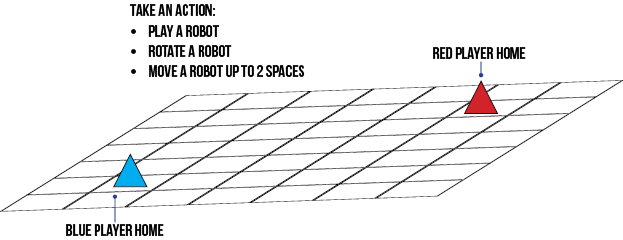Last week I casually brought up that I was working on a new game, and rambled on like a senile old man about its components. (“Back in my day, we didn’t have numbers on game pieces. We had shapes like triangles and birds’ feet, and you just had to count ’em!”)
Today I’d like to revisit Robot Drop in a little more detail. Specifically, let’s look at the game’s setup and turn sequence.
Setup
- The game is played (for now, at least) on a 7 x 7 grid. Each player has a “home” in one space of that grid.
- At the start of the game, each player shuffles his pile of 10 robots and draws three.
- One player is randomly chosen to go first.

Turn Sequence
The game is played in a series of turns. On your turn, do the following in order:
- Draw a robot.
- Take one action, which may be any of the following:
- Put a robot into play into an empty space on the board.
- Move a robot in a straight line up to two spaces (and yes, you can pass through friendly units).
- Rotate a robot any amount. (Remember: facing matters.)
- Count down all timers in the game. So if you just played a unit with a Timer value of 4, it counts down to 3. Or a robot with a current timer of 2 counts down to 1.
- Attack! All units that have counted down to zero attack simultaneously. When a robot attacks, it deals damage equal to its base Timer value to the first enemy robot in the direction that it’s facing. (Attacks pass through friendly units.) For example, if a robot has a Timer value of 4, it deals 4 damage.
- Reset all robots that have counted down to zero back to their based Timer values.
Victory
I’m still messing around with the victory conditions. The simplest and most traditional idea is that you win if you inflict 20 damage on your opponent’s Home. There will probably be some other ways to win too (control the magic Bot Spot? have the most birds’ feet?), but it’s a good place to start.

